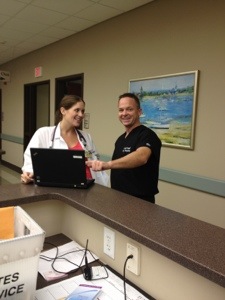Recently several commonly used diagnostic tests intended to screen for and detect early cancers have been called into question. Several articles in both the New York Times and Wall Street Journal have examined this issue in the last several weeks.
Recently several commonly used diagnostic tests intended to screen for and detect early cancers have been called into question. Several articles in both the New York Times and Wall Street Journal have examined this issue in the last several weeks. There has been a great deal of controversy surrounding the use of the PSA test to screen for prostate cancer. Prostate cancer affects one in six men in their lifetimes and is often a slow growing indolent tumor. While the screening test or PSA can provide early detection, it also has a very high rate of false positives and results in many unnecessary procedures and biopsies. Recently in July, 2012 the US Preventative Services task force recommended that PSA tests no longer be performed routinely in men who are asymptomatic. This week another article in the New York Times also questions the use of two screening tests for ovarian cancer– a blood test called Ca-125 and the trans-vaginal ultrasound evaluation. Ovarian cancer is a very aggressive, often fatal, form of cancer and is often widespread and advanced by the time it is diagnosed. The same US Preventative Services Task Force just made these new recommendations public. The task force recommends continued screening in high risk populations but suggests that routine screening may lead to false positive results and unnecessary and risky major surgeries. Much of the recommendations made by the task force are based on data from larger clinical trials.
So, What is a good screening test?
There are four characteristics that are required for an effective screening test:
1. The disease must have a detectable preclinical period before it becomes clinically apparent and can be detected by the screening test–The time in which we can impact outcome
2. The detectable preclinical period must allow detection while cure is possible–if we detect cancer early, treatment options are available which can impact outcome
3. Treatment must be more effective if given earlier–there must be a significant difference in treatment early vs late in a particular disease state in order to impact outcome
4. The disease must be sufficiently common in the population–The disease must be something that is a public health threat to large enough numbers of people in order for widespread screening to reduce late detection, facilitate better therapies and impact outcome
A good screening test must also be sensitive and specific, be acceptable in terms of risk and patient tolerability and must be cost effective. The test must be feasible for broad based use. If a disease is in fact highly prevalent but a screening test is accessible to only a small proportion of the population, it has little public health value. However, if a test is easily administered, safe and inexpensive, it can be used to screen entire populations. With accurate screening using good screening tests, outcomes are improved and overall healthcare costs are reduced.
The Bottom Line:
In this age of health care cost containment we must use testing in a more judicious and a more effective way. We must choose tests that have a reasonable chance of detecting and impacting disease such that we can alter and improve outcomes. Unnecessary testing and testing that yields high false positive rates only serves to drive up costs and can actually harm patients
through the performance of unnecessary and sometimes life-altering procedures.
Unlike therapy for disease, screening tests are performed in an asymptomatic healthy population. Even for common cancers with a well studied, reliable and accurate screening test (such as colon cancer or breast cancer), the majority of people being screened will not benefit as they are unlikely to develop the condition in the first place. Therefore, any population-wide screening test should have minimal risk; everyone who undergoes the test will be at risk for whatever the complication may be and only a minority of patients who are screened will actually benefit by early detection and treatment.
Special note: Thanks to Dr Deborah Fisher, Asso Professor of Medicine, Department of Gastroenterology, Duke University Medical Center for her assistance with the content and preparation of this manuscript. Dr Fisher is an expert in the use of diagnostic testing in Gastroenterology and is a member of the AGA Guidelines Committee.

